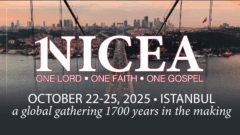I am in the midst of a series of articles on the seven ecumenical councils of the early church. These councils commenced with the First Council of Nicaea in 325 and concluded with the Second Council of Nicaea in 787. Between these two events were five more, each of which attempted to understand and establish a unified Christian theology.
In this series we are taking a brief look at each of the seven councils. For each one we are considering the setting and purpose, the major characters, the nature of the conflict, and then the results and lasting significance. We continue today with the Council of Ephesus.
Setting & Purpose
The Council of Ephesus was convened in 431 by Theodosius II, emperor of the eastern half of the Roman empire, and he did so at the request of Nestorius. Nestorius’ teaching about the nature of Christ was generating a great deal of controversy in the church, and he requested a council in the hopes of being able to prove his orthodoxy and silence his detractors. While Theodosius did not attend, he sent the head of his imperial palace guard, Count Candidian, to represent him. The council met in Ephesus, near present-day Selcuk in Turkey with between 200 and 250 bishops in attendance.
This council came at a time of conflict over authority within the church. The First Council of Constantinople had established the bishop of Constantinople as second in authority following Rome, whose bishop carried the title of Pope and who claimed his authority from the line of Peter. Alexandria and Antioch were also powerful bishoprics and their schools of Christology historically came from different positions. Leo Davis explains: “Just as all philosophers are said to be basically either Aristotelian or Platonist, so, roughly speaking, all theologians are in Christology either Antiochene, beginning with the Jesus of the Synoptic Gospels and attempting to explain how this man is also God, or Alexandrian, beginning with the Word of John’s Prologue and attempting to understand the implications of the Logos taking flesh.” This council would further expose the rift between the two schools of Christology.
Major Characters
Though he would not actually be present, the dominant personality at the Council of Ephesus was Nestorius who was originally from Antioch in Syria. Nestorious was a gifted speaker who had been appointed by Theodosius II as Archbishop of Constantinople. The second major character was Cyril, Archbishop of Alexandria. The two men would represent the two sides in a conflict with profound implications to the Christian faith.
The Conflict
Once in Constantinople, Nestorius found himself caught between two factions: one faction insisted on calling Mary Theotokos (“God-bearer”) while the other rejected the title because they held that an eternal being could not be born. (Theotokos was an ancient title for Mary that had been in use since the 3rd century, used by such men as Origen, Athanasius, and Gregory of Nazianzus.) In an attempt to mediate the dispute, Nestorius suggested calling Mary Christotokos (“Christ-bearer”). He wanted to affirm that Christ had a fully human nature rather than a nature mixed with his Deity. He also wanted to affirm the full reality of his Deity, which Nestorius believed could not involve change or suffering. By calling Mary Christotokos, Nestorius was suggesting that she gave birth to Christ, which was the prosopon (lit. in Greek “face” or “mask”) of the Son—the single perceived object of the Son, but internally consisting of two distinct natures, one human and the other divine.
When news of Nestorius’ teachings reached Cyril, he responded privately to Nestorius, but also publicly, and this resulted in several letters back and forth in what became a growing public debate. Some have suggested that Cyril was partly motivated not only by theology, but by the political implications of an Antiochene theologian now holding the chair of the second highest bishopric. In addition to these letters, Cyril wrote to Pope Celestine, who convened a synod in Rome and soon called for Nestorius to recant his teaching. Cyril also convened a synod in Alexandria, which came to the same decision. He wrote to Nestorius to deliver the news of both Rome’s and Alexandria’s synods and to call on him to recant. By this time Nestorius had already appealed to Theodosius II for a council and the emperor had agreed. At the council, Cyril would be the major defender of calling Mary Theotokos and the statement that Christ is the perfect unity of God and man.
Because the Pope did not attend the council, Cyril was made president. The council was scheduled to begin on June 7th but had to be postponed when a major contingency of bishops from the East (most notably John, the bishop of Antioch) had not arrived. On the 22nd, Cyril finally decided to convene the council without them. Despite repeated requests for his attendance, Nestorius refused to attend because of Cyril’s role as president. The council met and voted to affirm Cyril’s second letter to Nestorius (in which he had outlined his Christology in full) as in agreement with the Nicene Creed and to denounce Nestorius’ Christology (outlined in his response to Cyril’s second letter) as blasphemous and opposed to the faith of Nicaea.
When John and the Eastern bishops finally arrived, they were outraged to find that the council had already convened and come to a decision. They convened their own council immediately, condemning and excommunicating Cyril and others. Not surprisingly, this led to confusion, conflict, and intrigue. Ultimately, though, the decision of Cyril’s council was approved by both Rome and Constantinople.
The Result
The Council of Ephesus confirmed the Nicene Creed and the title Theotokos for Mary as a legitimate title based on that creed. They also condemned Nestorianism and excommunicated all those bishops who did not hold to the council’s decision.
Lasting Significance
The Council of Ephesus confirmed the hypostatic union of Christ as it was made explicit in the Nicene Creed. And, as Wikipedia aptly summarizes, this had long-lasting significance: “This precipitated the Nestorian Schism, by which churches supportive of Nestorius, especially in Persia, were severed from the rest of Christendom and became known as Nestorian Christianity, the Persian Church, or the Church of the East, whose present-day representatives are the Assyrian Church of the East, the Chaldean Syrian Church, the Ancient Church of the East, and the Chaldean Catholic Church.” Once again, Trinitarian doctrine had been defended and further clarified.









